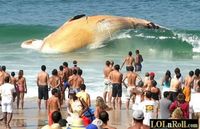Blue Whale
From ArticleWorld
The Blue Whale (Balaenoptera musculus), a marine mammal belonging to the suborder of baleen whales, is believed to be the largest animal in the world. It can grow up to 30 metres in length and 140 tonnes or more in weight. Though they were abundant in most oceans till the beginning of the 20th century, their numbers now have come down to three or four thousand individuals due to widespread hunting.
Contents |
Taxonomy and evolution
The Blue Whale belongs to the species of whale in the genus Balaenoptera. DNA sequencing analysis, however, shows that they are actually phylogenetically closer to the Humpback and Gray Whales than other species in its genus.
Physical description
Unlike other whales, the Blue Whale has a long tapering body with a flat U-shaped head and a prominent ridge running from the blowhole to the top of the upper lips. The front part of the mouth is thick. The dorsal fin is small and the shape varies from one individual to another. Other fins are prominent and are located around three-quarters of the way along the length of the body. The flippers are three to four metres long and gray in colour. The upper side is gray with a thin white border and the lower side is white. It usually has a mottled back.
Feeding
Krill is the exclusive food of Blue Whales. They try and locate the highest concentration of krills and then feed.
Life cycle
Their life span is estimated to be 80 years. They mate from autumn to winter though little is known about their mating behaviour. Females give birth once in two to three years after a gestation period of ten to twelve months.
Vocalisations
The Blue Whale is supposed to be the loudest animal in the world with their call sound being estimated at 155 and 188 decibels.
The hunting era
Because of their speed and power, Blue Whales are not easy to catch or kill. But as the population of other species declined, whalers increasingly hunted them and towards the end of the nineteenth century, their population in the North Atlantic diminished considerably and by the end of World War 11, their population significantly decreased. By the time their hunting was banned in 1960, they were a mere 1% of their previous population.
Population and distribution today
Their population is now constant at 3000 to 4000 individuals and they have been acknowledged as an endangered species. The largest concentration is in the North-East Pacific population that ranges from Alaska to Costa Rica. There have also been infrequent sightings between Kamchatka and the northern tip of Japan. The Southern Ocean population is estimated to be 750 to 1200. In the North Atlantic, off Greenland, Newfoundland, Nova Scotia and the Gulf of Lawrence, this group is estimated to be about 500 individuals. Another group in the same region is presumed to be only 100.
